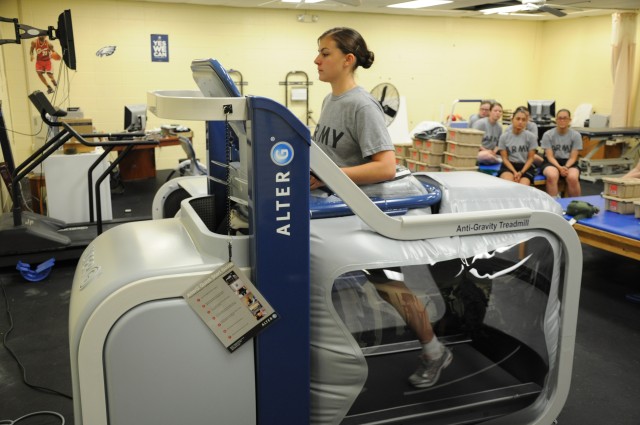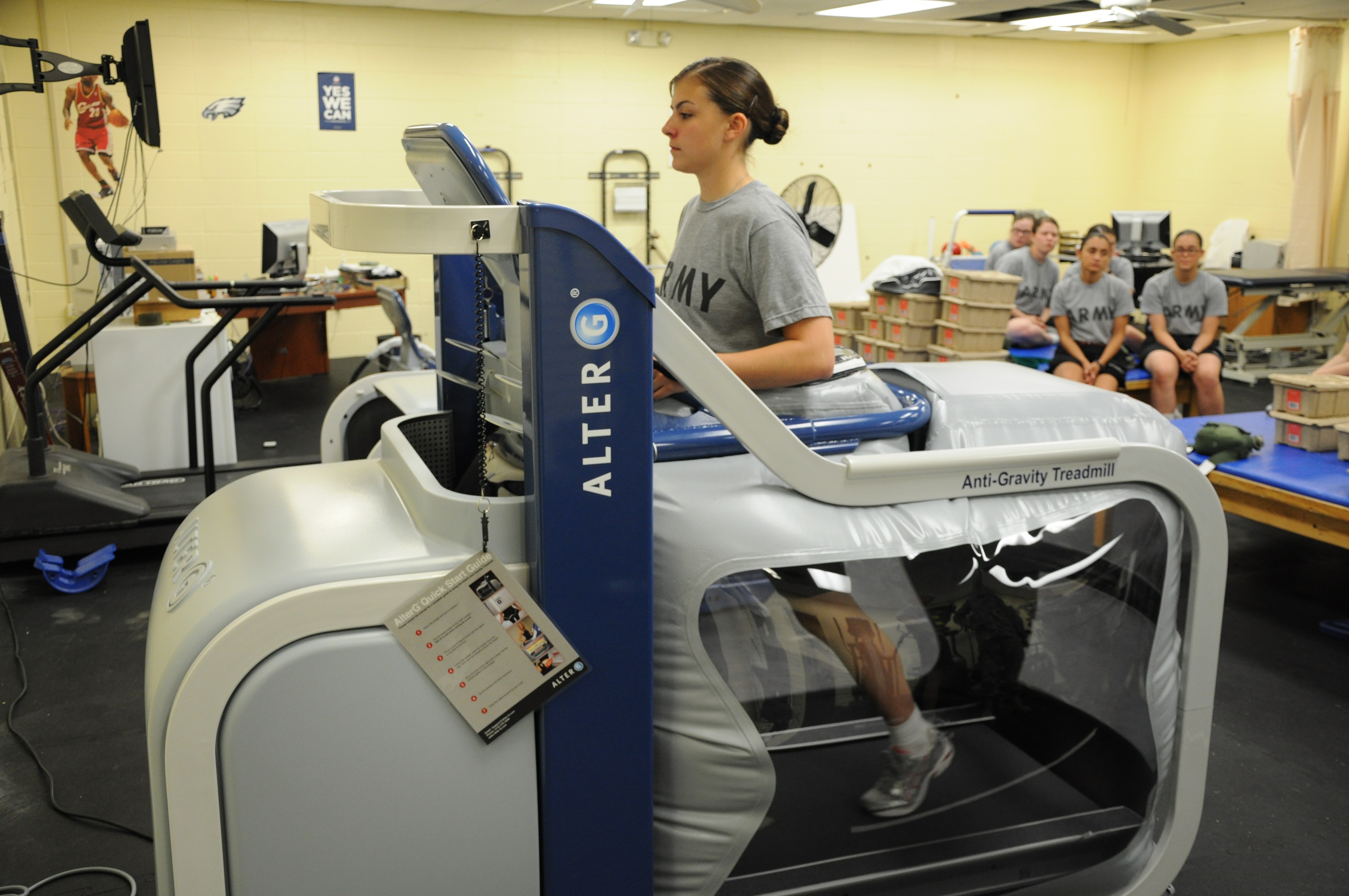FORT JACKSON, S.C. -- Fort Jackson Soldiers who are injured during Basic Combat Training have a new weapon at their disposal to get up and running again.
The 171st Infantry Brigade recently purchased three anti-gravity treadmills, which are designed to rehabilitate runners who have injuries to the lower back, legs or feet.
The machines allow injured Soldiers to train while putting less weight on the injured area by creating negative air pressure. The negative air pressure is adjustable and simulates the effect of walking or running in an environment with as little as 20 percent of the earth's gravity.
"With this technology, the device wraps around a patient's waist, using a pair of shorts that have a zipper that attaches to, essentially, a balloon. The legs are inside the balloon, and then the balloon inflates and lifts them up. That allows the legs, arms and upper body to move in a normal running motion," said Maj. David Feltwell, the 171st surgeon. "This machine allows us to take the weight off someone's legs down to a point where he or she is essentially doing the equivalent of walking or running on the moon."
Feltwell said the machines will be especially helpful in getting injured Soldiers in the Physical Training and Rehabilitation Program ready to continue with Basic Combat Training.
"Most of the Soldiers who go in that program who do well historically have lower-extremity bone injuries. Their bones have become stressed by the physical demands of Basic Combat Training, have not been able to keep up with that stress and have failed in some way," Feltwell said. "The trick is to rehabilitate them safely to a point where they can go back into training and complete (it) without being at risk for re-injury. We have a limited amount of time to do that. We can't keep people there indefinitely. We want to return them to training as quickly as possible, and safely."
Col. Karl Reed, 171st commander, said when Feltwell told him about the anti-gravity treadmills, he wanted to experience for himself what running on one would be like.
"We went offsite into the local community and found one of those (treadmills)," Reed said. "I actually got in it and ran. ... It's like running on air, like in a cloud."
Reed said buying the machines was the right thing to do as part of the Army's responsibility to making sure Soldiers get the best possible care in their rehabilitation from injuries.
"I think it's a fantastic thing," he said. "I think every installation that has a necessity for rehab for lower-extremity injuries, to include lower back (injuries), ought to have this capability."
On average, about 700 Fort Jackson Soldiers are in the PTRP annually. Approximately 85 percent of those Soldiers have injuries to the lower extremities or the hips. Before the Soldiers can continue with BCT, they have to pass the Army Physical Fitness Test, including the 2-mile run.
Soldiers usually go through a stepped progression to achieve that fitness level, said Capt. Dan Summers, commander of the Fitness Training Company, which is responsible for the PTRP. After working on core stability, Soldiers move on to intermediate and advanced agility exercises before two weeks of walk-to-run training, he explained.
"What we've seen in the past is getting (Soldiers) all the way up to (the) advanced agility area, we have really good luck with the stress fractures and the stress reactions in the femoral neck," Summers said. "But once we hit there, that's either where they start feeling that pain again and they're not able to continue on, their stress fracture or stress reaction kicked back up; or right afterward when we start putting them back on the track running, that's when it hits."
Summers said he hopes to decrease the rehabilitation time by allowing Soldiers to start their running routine on the treadmill before they can put full weight on their bodies.
"My hope is that while they're going through intermediate and advanced agility, they're also increasing the time and weight that they're doing on the treadmill," he said. "So by the time they've finished the advanced agility, they're ready to (be) out running on the track and pass the PT test."
Pvt. Bonnie Beaver has been in the PTRP for more than 90 days because of a hip injury. She said she had tried running unsuccessfully. Beaver was one of the first Soldiers to use the new equipment and said the difference to conventional running was very noticeable.
"It was definitely an experience," she said. "I didn't have any pain at all, and usually if I power walk or jog or sprint I feel a little tension in my hips. (On the treadmill) I didn't feel any tension or pain at all."


Social Sharing